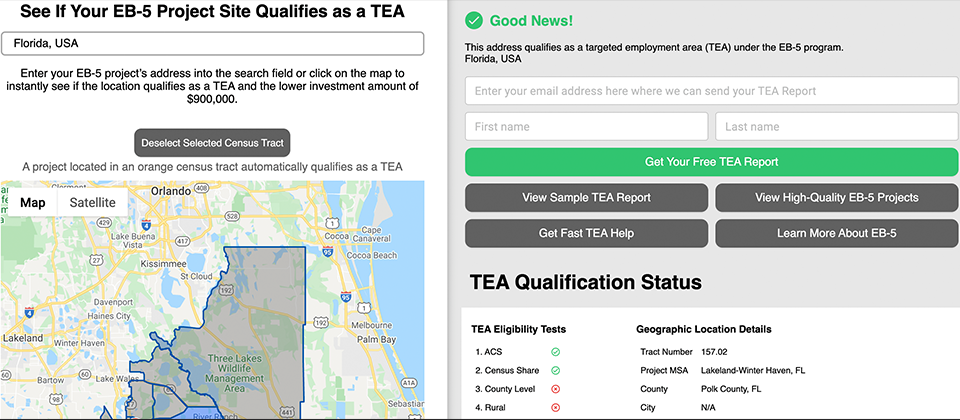Free Targeted Employment Area Map for All 50 States

Click the image above to view the EB5AN TEA map
How to Get a TEA Letter: Step-by-Step Instructions
United States Citizenship and Immigration Services (USCIS) defines a targeted employment area (TEA) as a high-unemployment or rural area. The minimum qualifying EB-5 investment within either a high-unemployment area or rural area is currently $800,000.
A TEA is an area that, at the time of EB-5 investment, is a rural area or an area experiencing unemployment of at least 150% of the national average rate. In other words, if the national average unemployment rate is 5.32%, the minimum qualifying threshold for EB-5 projects in high-unemployment areas is 7.98%.
Projects Located in Rural Areas
A rural area is any area outside a metropolitan statistical area as designated by the Office of Management and Budget or outside the boundary of any city or town having a population of 20,000 or more according to the most recent decennial census. If your project is located in a rural area, it automatically qualifies as a TEA and you can get in touch with the correct state agency to request an official EB-5 TEA approval letter.
Projects Located in High-Unemployment Areas
Most EB-5 projects are not located within rural areas but are located in high-unemployment areas. Even if your project is not located in a rural area, it may still qualify as a high-unemployment area with a combined unemployment rate that is 150% of the national average rate.
The first step is to determine the census tract the potential EB-5 regional center project is located in. For this, you need the exact address of the project location. Enter the EB-5 project address into the EB5AN TEA map to determine in which census tract your project is located. The map will indicate whether the specific tract your project is located in automatically qualifies as a TEA.
If your project is located in a census tract that automatically qualifies as a TEA, all you need to do is contact the correct state agency with your project’s address and formally request a TEA letter.
Combining Census Tracts to Form a Targeted Employment Area
If your project is not located in a census tract that automatically qualifies as a TEA, try combining surrounding, contiguous census tracts to see if a combination of census tracts together results in the required level of unemployment to qualify as a TEA. This method of combining census tracts is approved, although some states limit the number of tracts that can be combined to form a TEA.
If you believe your project may qualify using the census tract combination method, you can contact the correct state agency directly with a list of selected census tracts that result in the required unemployment rate and see if it will be approved. Success is not guaranteed, but most of our TEA letter requests have been approved.
Dealing with State Agencies when Applying for Targeted Employment Area Designation
Although state agencies are subject to the same federal EB-5 rules, their processes and procedures differ. Some state agencies allow a petitioner to submit their own calculated request for a TEA letter if it does not automatically qualify in the exact census tract or as a rural area and will help the petitioner to determine if the location may be approved using the census tract combination method.
However, the number of census tracts that can be combined for a specific project varies across agencies. Some states, such as California, set a specific number of census tracts that can be combined; California limits this to 12 census tracts. Other states, such as Florida and Pennsylvania, are much more flexible, and we have helped clients obtain TEA letters for regions with more than 60 combined census tracts.
Sample TEA Letter



 (1).jpg)









